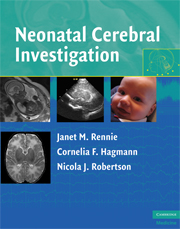Book contents
- Frontmatter
- Contents
- List of contributors
- Preface
- Acknowledgements
- Glossary and abbreviations
- Section I Physics, safety, and patient handling
- Section II Normal appearances
- Section III Solving clinical problems and interpretation of test results
- 7 The baby with a suspected seizure
- 8 The baby who was depressed at birth
- 9 The baby who had an ultrasound as part of a preterm screening protocol
- 10 Common maternal and neonatal conditions that may lead to neonatal brain imaging abnormalities
- 11 The baby with an enlarging head or ventriculomegaly
- 12 The baby with an abnormal antenatal scan: congenital malformations
- 13 The baby with a suspected infection
- 14 Postmortem imaging
- Index
- References
14 - Postmortem imaging
from Section III - Solving clinical problems and interpretation of test results
Published online by Cambridge University Press: 07 December 2009
- Frontmatter
- Contents
- List of contributors
- Preface
- Acknowledgements
- Glossary and abbreviations
- Section I Physics, safety, and patient handling
- Section II Normal appearances
- Section III Solving clinical problems and interpretation of test results
- 7 The baby with a suspected seizure
- 8 The baby who was depressed at birth
- 9 The baby who had an ultrasound as part of a preterm screening protocol
- 10 Common maternal and neonatal conditions that may lead to neonatal brain imaging abnormalities
- 11 The baby with an enlarging head or ventriculomegaly
- 12 The baby with an abnormal antenatal scan: congenital malformations
- 13 The baby with a suspected infection
- 14 Postmortem imaging
- Index
- References
Summary
Introduction to the clinical problem
Establishing the cause of perinatal death has a particularly valuable role in the counseling of the parents after a loss of a baby. Assigning a cause of death can help parents in the grieving process, improve parental and professional understanding, and address any concerns they may have that prenatal events such as maternal illness or maternal use of medication might have contributed to the death of their baby [1,2,3,4]. After termination, confirmation of the prenatal diagnosis is vitally important information when counseling for future pregnancies.
Despite the recognized value of autopsy, perinatal autopsy rates have declined significantly in recent years [2,3,5]. Studies in both Europe and the United States indicate that as many as 40% of all perinatal deaths are not submitted for autopsy [6,7,8]. There is no obvious single explanation for the decline in autopsy rates but possible influences include a shift in attitude of clinicians towards autopsies and a change in the public's willingness to grant permission [3].
This decline in consent for autopsy leads to a reduction in the information available to parents about the risk for future pregnancies. The Chief Medical Officer of the United Kingdom issued two reports in 2000 and 2001 [9,10] recommending the assessment of less invasive forms of postmortem examination. After wide consultation with interested parties and faith groups, Alistair Parker produced a document (on behalf of the Department of Health) entitled Less Invasive Autopsy: The Place of MR Imaging in 2004 [11].
- Type
- Chapter
- Information
- Neonatal Cerebral Investigation , pp. 281 - 283Publisher: Cambridge University PressPrint publication year: 2008



